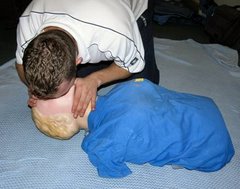Fainting
Fainting is a brief loss of consciousness caused by temporary reduction of blood flow to the brain. It can be caused by pain, exhaustion, lack of food and stress. Fainting often occurs after long periods of inactivity, when blood has pooled in the lower body and isn't fully reaching the brain. When a person faints their pulse becomes very slow, but this quickly returns to normal as they recover.
Recognition:
- A brief period of unconsciousness.
- A slow pulse.
- Pale, cold and clammy skin.
Aims:
- To improve blood flow to the brain.
- To reassure and make he casualty comfortable.
Treatment:
- If the casualty feels faint ask them to lie down (before they fall). Kneel next to them and raise their legs, supporting their ankles on your shoulders. Alternatively support the legs on a chair etc.
- Make sure the casualty gets plenty of fresh air by opening a window etc.
- As the casualty recovers gently get them to sit up gradually. If they feel faint ask them to lie down once again.
- Be prepared to resuscitate if the casualty stops breathing. In this call for an ambulance quickly.


